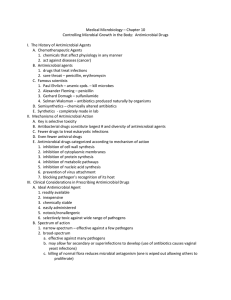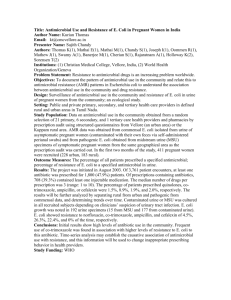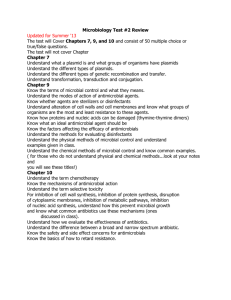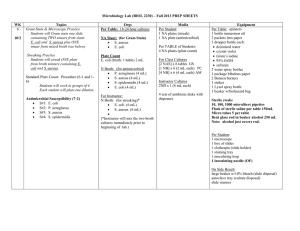Document 13310846
advertisement
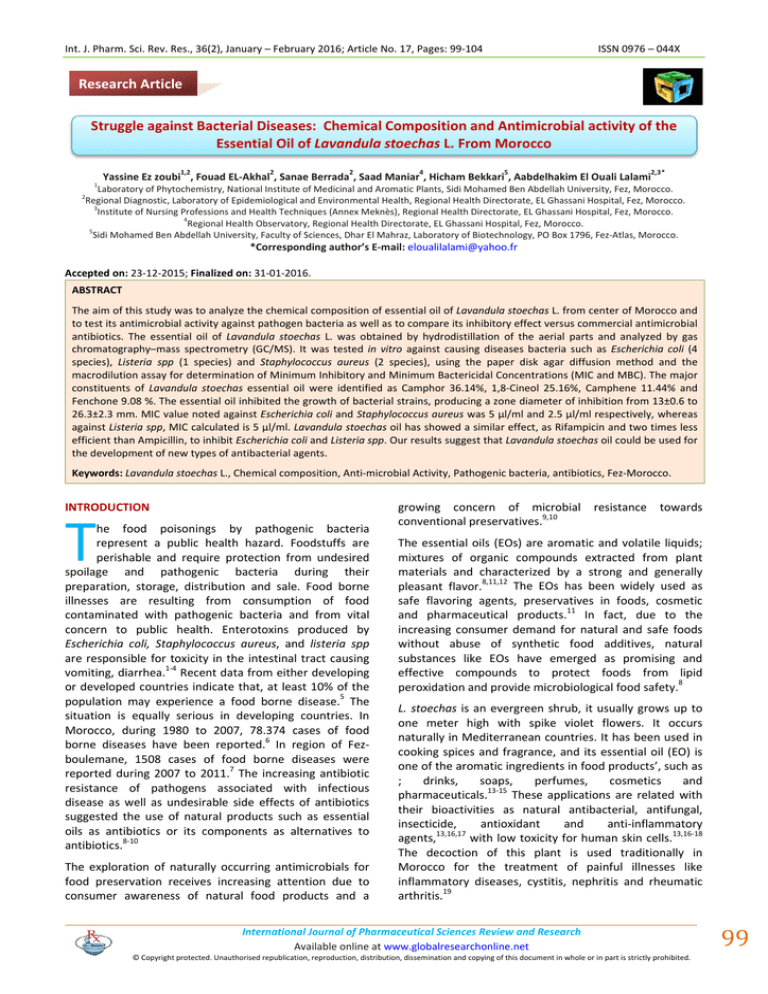
Int. J. Pharm. Sci. Rev. Res., 36(2), January – February 2016; Article No. 17, Pages: 99‐104 ISSN 0976 – 044X Research Article Struggle against Bacterial Diseases: Chemical Composition and Antimicrobial activity of the Essential Oil of Lavandula stoechas L. From Morocco 1,2 1 2 2 4 5 2,3* Yassine Ez zoubi , Fouad EL‐Akhal , Sanae Berrada , Saad Maniar , Hicham Bekkari , Aabdelhakim El Ouali Lalami Laboratory of Phytochemistry, National Institute of Medicinal and Aromatic Plants, Sidi Mohamed Ben Abdellah University, Fez, Morocco. 2 Regional Diagnostic, Laboratory of Epidemiological and Environmental Health, Regional Health Directorate, EL Ghassani Hospital, Fez, Morocco. 3 Institute of Nursing Professions and Health Techniques (Annex Meknès), Regional Health Directorate, EL Ghassani Hospital, Fez, Morocco. 4 Regional Health Observatory, Regional Health Directorate, EL Ghassani Hospital, Fez, Morocco. 5 Sidi Mohamed Ben Abdellah University, Faculty of Sciences, Dhar El Mahraz, Laboratory of Biotechnology, PO Box 1796, Fez‐Atlas, Morocco. *Corresponding author’s E‐mail: eloualilalami@yahoo.fr Accepted on: 23‐12‐2015; Finalized on: 31‐01‐2016. ABSTRACT The aim of this study was to analyze the chemical composition of essential oil of Lavandula stoechas L. from center of Morocco and to test its antimicrobial activity against pathogen bacteria as well as to compare its inhibitory effect versus commercial antimicrobial antibiotics. The essential oil of Lavandula stoechas L. was obtained by hydrodistillation of the aerial parts and analyzed by gas chromatography–mass spectrometry (GC/MS). It was tested in vitro against causing diseases bacteria such as Escherichia coli (4 species), Listeria spp (1 species) and Staphylococcus aureus (2 species), using the paper disk agar diffusion method and the macrodilution assay for determination of Minimum Inhibitory and Minimum Bactericidal Concentrations (MIC and MBC). The major constituents of Lavandula stoechas essential oil were identified as Camphor 36.14%, 1,8‐Cineol 25.16%, Camphene 11.44% and Fenchone 9.08 %. The essential oil inhibited the growth of bacterial strains, producing a zone diameter of inhibition from 13±0.6 to 26.3±2.3 mm. MIC value noted against Escherichia coli and Staphylococcus aureus was 5 µl/ml and 2.5 µl/ml respectively, whereas against Listeria spp, MIC calculated is 5 µl/ml. Lavandula stoechas oil has showed a similar effect, as Rifampicin and two times less efficient than Ampicillin, to inhibit Escherichia coli and Listeria spp. Our results suggest that Lavandula stoechas oil could be used for the development of new types of antibacterial agents. Keywords: Lavandula stoechas L., Chemical composition, Anti‐microbial Activity, Pathogenic bacteria, antibiotics, Fez‐Morocco. INTRODUCTION T he food poisonings by pathogenic bacteria represent a public health hazard. Foodstuffs are perishable and require protection from undesired spoilage and pathogenic bacteria during their preparation, storage, distribution and sale. Food borne illnesses are resulting from consumption of food contaminated with pathogenic bacteria and from vital concern to public health. Enterotoxins produced by Escherichia coli, Staphylococcus aureus, and listeria spp are responsible for toxicity in the intestinal tract causing vomiting, diarrhea.1‐4 Recent data from either developing or developed countries indicate that, at least 10% of the population may experience a food borne disease.5 The situation is equally serious in developing countries. In Morocco, during 1980 to 2007, 78.374 cases of food borne diseases have been reported.6 In region of Fez‐ boulemane, 1508 cases of food borne diseases were reported during 2007 to 2011.7 The increasing antibiotic resistance of pathogens associated with infectious disease as well as undesirable side effects of antibiotics suggested the use of natural products such as essential oils as antibiotics or its components as alternatives to antibiotics.8‐10 The exploration of naturally occurring antimicrobials for food preservation receives increasing attention due to consumer awareness of natural food products and a growing concern of microbial resistance towards conventional preservatives.9,10 The essential oils (EOs) are aromatic and volatile liquids; mixtures of organic compounds extracted from plant materials and characterized by a strong and generally pleasant flavor.8,11,12 The EOs has been widely used as safe flavoring agents, preservatives in foods, cosmetic and pharmaceutical products.11 In fact, due to the increasing consumer demand for natural and safe foods without abuse of synthetic food additives, natural substances like EOs have emerged as promising and effective compounds to protect foods from lipid peroxidation and provide microbiological food safety.8 L. stoechas is an evergreen shrub, it usually grows up to one meter high with spike violet flowers. It occurs naturally in Mediterranean countries. It has been used in cooking spices and fragrance, and its essential oil (EO) is one of the aromatic ingredients in food products’, such as ; drinks, soaps, perfumes, cosmetics and pharmaceuticals.13‐15 These applications are related with their bioactivities as natural antibacterial, antifungal, insecticide, antioxidant and anti‐inflammatory agents,13,16,17 with low toxicity for human skin cells.13,16‐18 The decoction of this plant is used traditionally in Morocco for the treatment of painful illnesses like inflammatory diseases, cystitis, nephritis and rheumatic arthritis.19 International Journal of Pharmaceutical Sciences Review and Research Available online at www.globalresearchonline.net © Copyright protected. Unauthorised republication, reproduction, distribution, dissemination and copying of this document in whole or in part is strictly prohibited. 99 Int. J. Pharm. Sci. Rev. Res., 36(2), January – February 2016; Article No. 17, Pages: 99‐104 ISSN 0976 – 044X The aim of this study was to identify the chemical composition of essential oil of L. stoechas L. collected in center of Morocco and to test its antimicrobial activity against some food borne pathogenic bacteria such as E. coli, Listeria spp, and S. aureus as well as to compare its inhibitory effect versus commercial antimicrobial antibiotics. This is the first report on the antimicrobial properties of this essential oil of L. stoechas collected in center of Morocco against food borne pathogens. MATERIALS AND METHODS These microorganisms were obtained from the Microbiology Unit at the Regional Diagnostic Laboratory Epidemiological and Environmental Hygiene (RDLEH) falling within Regional Health Directorate of Fez. This laboratory follows the requirements of the NM ISO 17025 since 2008. Disc diffusion assay Plant material The aerial parts of L. stoechas (branches, leaves and flowers) are collected in Taounate province / Morocco, between April and June 2014. Then they are air‐dried at 40° C with forced ventilation for two days. The botanical identification and authenticated voucher specimens deposited in the Herbarium of The National Institute of Medicinal and Aromatic Plants, Sidi Mohamed Ben Abdellah University, Fez‐30000, Morocco. Extraction of the essential oil (EO) Samples of 100 g of the air‐dried aerial parts of L. stoechas were subjected to hydrodistillation for 2 hours using a Clevenger apparatus. The obtained EO was dried over anhydrous sodium sulphate and, after filtration, stored at 4 °C until it tested. All experiments were conducted in triplicates and results were expressed on the basis of dry matter weight. Chemical characterization of essential oil of Lavandula stoechas The essential oil is dried over anhydrous sodium sulfate and is stored in a glass vial and sealed opaque at 4 °C in the shade. The essential oil was analyzed using Gas chromatography (GC) coupled to mass spectrometry GC / MS (Polaris Q ion trap MS), analyses were performed on a Hewlett‐Packard (HP 6890) gas chromatograph (FID), equipped with a 5% phenyl methyl silicone HP‐5 capillary column (30m x 0.25 mm x film thickness 0.25 µm). The temperature was programmed from 50°C after 5 min initial hold to 200°C at 4°C/min. Gas chromatography were as follows: nitrogen as carrier gas (1.8 ml/min), split mode was used (Flow: 72.1 ml/min, ratio: 1/50), temperature of injector and detector was 250°C, Final hold time was 48 min. The machine was led by a computer system type “HP ChemStation”, managing the functioning of the machine and allowing to follow the evolution of chromatographic analyses. Diluted samples (1/20 in methanol) of 1µl were injected manually. Antimicrobial activity Microorganisms The antimicrobial activity of L. stoechas essential oil was tested against two Gram positive bacterial strains Staphylococcus aureus, and five Gram negative bacterial strains Escherichia coli, Listeria spp. These bacteria have been isolated from food samples having caused poisoning. They have been identified and confirmed by classical biochemical gallery and the API (Biomerieux, France). Antimicrobial susceptibility test of the essential oil was tested against the above mentioned Gram positive, Gram negative bacteria by disc diffusion method.20 The susceptibility tests were performed on Muller–Hinton Agar 10 µl of essential oil was diluted with two volumes of 5% dimethyl sulfoxide (DMSO) and impregnated on the filter paper discs and used for the study. Ampicilin, Chloramphenicol and Rifampicin were used as positive reference standards to determine the sensitivity of the tested strains and 5% DMSO was used as blind control. Finally, the inoculated plates were incubated at 37 °C for 24 h and the inhibition zones were observed including the diameter of the disc (6 mm). If the inhibition zone exceeds 15mm in diameter, we consider the antimicrobial activity as very good. If the diameter is between 15mm and 8mm, the antibacterial activity is average. For diameters below 8mm, the antibacterial activity is weak. Determination of Minimum Inhibitory Concentration (MIC) The Minimal Inhibition Concentration (MIC) values were evaluated according to published procedures.21‐23 The test oil was dissolved in 5% DMSO to obtain 1000 µl/ml stock solution. 0.5 ml of stock solution was incorporated into 0.5 ml of Mueller Hinton broth to get the concentration of 500 µl/ml and serially diluted to achieve 0.62, 1.25, 2.5, 5, 10, 20 and 40 µl/ml. Fifty microliters of standardized suspension of the test organism was transferred on to each tube. The control tube contained only organisms and not the essential oil and 5% DMSO was used as blind control. The culture tubes were incubated at 37 °C for 24 hours. The lowest concentrations, which did not show any growth of tested organisms after macroscopic evaluation was determined as MIC. Determination of Minimum Bactericidal Concentrations (MBC) Referring to results of the MIC assay, the Minimum Bactericidal Concentration (MBC) was determined. Fifty microliters from each dilution of essential oil, showing growth inhibition zone in disc diffusion method, were added to 5 ml of Tryptic Soy Agar (TSA) broth tubes then incubated at 37 °C for 24 hours in an incubator shaker. From tubes without microbial growth, 0.1 ml of cells was spread on TSA Agar plates. MBCs were determined as the International Journal of Pharmaceutical Sciences Review and Research Available online at www.globalresearchonline.net © Copyright protected. Unauthorised republication, reproduction, distribution, dissemination and copying of this document in whole or in part is strictly prohibited. 100 Int. J. Pharm. Sci. Rev. Res., 36(2), January – February 2016; Article No. 17, Pages: 99‐104 ISSN 0976 – 044X highest dilution at which no growth occurred on the plates. Statistical analysis The antimicrobial results are expressed as mean ± SD. One‐way analysis of variance (ANOVA). RESULTS Percent yield and physical characters of L. stoechas The percent yield of the hydro‐distilled volatile oil from aerial parts of L. stoechas and its physical characters are summarized in Table 1. Component analysis of essential oil of L. stoechas Totally 20 compounds were identified and accounted for 90.22% of total oil. The major chemical compounds of essential oil were: camphor (36.14%), 1.8‐cineole (25.16%), camphene (11.44%) and fenchone (9.08 %). The percentage compositions of remaining 16 compounds ranged from 0.12% to 1.975%. Disc diffusion study The in vitro results of antibacterial activity of the EO of L. stoechas by the paper disk agar diffusion method against seven microorganisms of significant importance are summarized in Table 2. On the two species of E. coli (15 ± 0.5 and 17.3 ± 0.55 mm) tests showed an inhibition zone above 15mm, two author’s species (14 ± 1 and 13 ± 0.6 mm) showed an inhibition zone between 8mm and 15 mm and two species of staphylococcus aureus an inhibition zone above 15 mm. Listeria spp (13.5 ± 1.3 mm) showed an inhibition zone between 8mm and 15 mm. The EO inhibited the growth of bacterial strains, producing a zone diameter of inhibition from 13 ± 0.6 to 26.3 ± 2.3 mm. The essential oil of L. stoechas exhibited notable antibacterial activity against all the bacteria species tested. The inhibition zone of Chloramphenicol against E. coli, S. aureus and Listeria spp showed between 14 ± 1 and 19.5 ± 2.2 mm. The bacterium S. aureus had a resistance for Ampicillin, and a low sensitivity for Rifampicin (between 12.2 ± 1.4 and 12.4 ± 1.6 mm). All species of E. coli and listeria spp has a low sensitivity for Ampicillin (6.5 ± 1.2 to 7 ± 1.2 mm) and average sensitivity for Rifampicin (11 ± 1.5 to 12.8 ± 1.5 mm). Determination of Minimum Inhibitory Concentration (MIC) and Minimum Bactericide Concentration (MBC) The high antimicrobial activity of L. stoechas was confirmed by the macrodilution assay (Table 3), exhibiting minimal inhibitory concentration values of 5 µl/ml, 5 µl/ml and 2.5 µl/ml against E. coli, Listeria spp and S. aureus respectively. L. stoechas EO exhibited antimicrobial activity against all tested strains. Inhibition values for MIC=5 mg/ml and MBC= 10 mg/ml for E. coli, and MIC= 5 µl/ml and MBC= 10 µl/ml for Listeria spp. Table 1: Percent yield and physical characters of Lavandula stoechas from center of Morocco Family and botanical name Lavandula steochas L. English name Physical characteristics Part used Topped lavander or French lavander Areal part Color Odor Density (g/ml) % Yield Light yellow Rustic, bitter and herbaceous 0.932 1.74±0.24 Table 2: Antimicrobial activity of L. stoechas essential oil and antibiotics using disc diffusion method Inhibition zone diameter (mm)* Microorganisms Origin of bacteria Antibiotics Essential oil of L. stoeochas (10 µg/disc) Ampicillin (10µg per disc) Chloramphenicol (5µg per disc) Rifampicin (10 µg per disc) Escherichia coli Fresh cream 15±0.5 7±1 19.5±2.2 12±0.6 Escherichia coli Baking bun 14±1 6.5±1.2 19±3.2 12.5±1.1 Escherichia coli Cooked ground meat 17.3±0.55 6.8±0.7 18.4±1.9 12.8±1.5 Escherichia coli Dairy (milk product) 13±0.6 7±1.2 19±1.1 11.5±1.4 Listeria spp Cooked meat 13.5±1.3 7±0.5 15±0.8 11±1.5 Staphylococcus aureus Potato dough 26.3±2.3 NI 14.5±1.2 12.4±1.6 Staphylococcus Cheese 24.5±3.1 NI 14±1 12.2±1.4 aureus *: Inhibition zone including disc diameter (6 mm); ‐ Values represent averages ± standard deviations for triplicate. ‐ NI: no inhibition. International Journal of Pharmaceutical Sciences Review and Research Available online at www.globalresearchonline.net © Copyright protected. Unauthorised republication, reproduction, distribution, dissemination and copying of this document in whole or in part is strictly prohibited. 101 Int. J. Pharm. Sci. Rev. Res., 36(2), January – February 2016; Article No. 17, Pages: 99‐104 ISSN 0976 – 044X Table 3: Antimicrobial activity of L. stoechas essential oil using macro‐ dilution method Microorganisms Origin of bacteria Escherichia coli Essential oil of L. stoechas MIC (µl/ml) MBC (µl/ml) Fresh cream 5 10 Escherichia coli Baking bun 5 10 Escherichia coli Cooked ground meat 5 10 Escherichia coli Dairy (milk product) 5 10 Listeria spp Cooked meat 5 10 Staphylococcus aureus Potato dough 2.5 2.5 Staphylococcus aureus Cheese 2.5 5 DISCUSSION Average yield L. stoechas essential oil was 1.74 ± 0.24%. It should be noted that this yield is higher than that reported by C.N. Hassiotis, studying L. stoechas from Greece (1.46 %),24 moreover this species, in general, has an average higher than other species of lavender.24,25 L. stoechas have been object of several phytochemical studies that have pointed out a high chemical variability allowing the establishment of several chemotypes. L. stoechas oil is characterized by significant variations in the amounts of fenchone, camphor and 1.8‐cineole, being the fenchone/camphor chemotype the most commonly identified.13,17,26‐28 Our study shows that L. stoechas essential oil composition is characterized by the presence of Camphor 36.14%, 1,8‐Cineol 25.16%, camphene 11.44% and fenchone 9.08 % as major components. It is clear that essential oils from these aromatic plants are rich in monoterpenoids, compounds that possess antibacterial activity against various bacteria’s species. The different qualitative and quantitative chemical compositions of the EO with respect to previous investigations could be related first and foremost to different environmental conditions, genetics (degree of hybridization), geographical origin and harvest period. The effect of the method of extraction on the resulting chemical composition has been also reported.29‐31 In a first set of experiments, antimicrobial activity was evaluated by the disc diffusion method. EO of L. stoechas also found to be more effective (between 13 ± 0.6 and 26.3 ± 2.3 mm inhibition diameter) than Ampicillin and Rifampicin antibiotics (between 6.5 ± 1.2 and 12.8 ± 1.5 mm) to inhibit E. coli, Listeria spp and S. aureus. Chloramphenicol produced inhibition zones between 18.4 ± 1.9 and 19.5 ± 2.2 mm for E. coli and 15 ± 0.8 mm for Listeria spp., reported the essential oil with the greatest spectrum of activity against S. aureus as following order: L. stoechas > Chloramphenicol > Rifampicin > Ampicillin (Table 2). L. Cherrat found that oil of L. stoechas exhibited the highest antimicrobial activity against E. coli O157, Listeria monocytogenes, and S. aureus with inhibition zone of 16.2 ± 0.60, 32.0 ± 2.00 and 28.0 ± 0.70 mm respectively.32 The gram positive bacterium is more susceptible to the antimicrobial properties of essential oil than gram negative bacteria and it is considered to be due to its outer membrane.33,34 The results obtained by macro‐dillution method are shown in Table 3. EO of L. stoechas exhibited a great antibacterial activity against all tested bacteria (MIC between 2.5 and 5 µl/ml). The antimicrobial activity of this EO confirms its strong antimicrobial activity comparable with data reported in north of Morocco (Tangier) with a MIC of 14, 8.0, and 2.0 µl/ml for E.coli, L. monocytogenes and S. aureus respectively.32 EO was bactericidal to all the tested strains at higher values of MBC than MIC values in accordance with previous studies.32 Camphor the major component of L. stoechas EO analyzed has antibacterial properties itself.35‐37 Moreover, it has been demonstrated that eucalyptol, one of the primary components of both EO studied, presents antimicrobial activity against bacteria such as S. aureus, E. coli and L. monocytogenes.38 The same study also suggests the synergistic effect of minor components in the chemical composition of the EOs in relation to its antimicrobial activity, similar results having been reported in other studies, along with additive and antagonistic effects.39,40 EOs represent complex mixtures of chemical compounds with different antimicrobial properties, and for these reasons it is very difficult to reduce their antimicrobial effect to one or several active principles.33 Limitations of employing essential oils and components as food antimicrobials include changes in sensory attributes such as aroma and flavor, furthermore, solubility difficulties associated with lipophilic nature. However, recent encapsulation techniques using various surfactants seem to overcome such problems.41 Appropriate essential oil selections and usage according to the type of food can also overcome undesirable organoleptic characters while preventing the growth of microorganisms. International Journal of Pharmaceutical Sciences Review and Research Available online at www.globalresearchonline.net © Copyright protected. Unauthorised republication, reproduction, distribution, dissemination and copying of this document in whole or in part is strictly prohibited. 102 Int. J. Pharm. Sci. Rev. Res., 36(2), January – February 2016; Article No. 17, Pages: 99‐104 ISSN 0976 – 044X CONCLUSION The essential oil of L. stoechas was chemically analyzed and antimicrobial activity in vitro against common food borne bacteria was determined. Regarding the chemical analysis, the major compounds identified were camphor, cineol, fenchone and camphene respectively. L. stoechas oil evaluated in this study exhibited a great antibacterial activity against all the tested bacteria in compared with antibiotics such as showed a similar effect, as Rifampicin and two times less efficient than Ampicillin, to inhibit Escherichia coli and Listeria spp. These results also indicate the possible use of the essential oil on food system as an effective inhibitor of food borne pathogen. REFERENCES 1. D’Mello JPF. Food safety: Contaminants and toxins. Oxford: CABI Publications, 2003. 2. Harris RC. Review of selected bacterial enterotoxins and their role in gastroenteritis. Annals of Clinical and Laboratory Science, 18, 1988, 102–108. composition, chemical variability, and in vitro biological properties. Chem. Biodivers., 8, 2011, 937–953. 14. Msaada K, Salem N, Tammar S, ammami M, Saharkhiz MJ, Debiche N, Limam F, Marzouk B. Essential Oil Composition of Lavandula dentata, L. stoechas and L. multifida cultivated in Tunisia. J. Essent. Oil‐Bear. Plants, 15(6), 2012, 1030–1039. 15. Zuzarte M, Goncalves MJ, Cavaleiro C, Cruz MT, Benzarti A, Marongiu B, Maxia A, Piras A, Salgueiro. Antifungal and anti‐inflammatory potential of Lavandula stoechas and Thymus herba‐barona essential oils. Ind. Crops Prod., 44, 2013, 97–103. 16. Yassine E, Dalila B, Mohammed L, Abdellah F. Antioxidant and Anti‐inflammatory Properties of Ethanolic Extract of Lavandula Stoechas l. from Taounate region in Morocco. International Journal of Phytopharmacology, 5(1), 2014, 21‐26. 17. Messaoud C, Chongrani H, Boussaid M. Chemical composition and antioxidant activities of essential oils and methanol extracts of three wild Lavandula L. species. Nat. Prod. Res., 26, 2012, 1976–1984. 3. Rocourt J, Moy G, Vierk K, & Schlundt J. The present state of foodborne disease in OECD countries. Geneva: WHO Publications, 2003. 18. Kaya DA, Inan M, Giray ES, Kirici S. Diurnal, ontogenetic and morphogenetic variability of Lavandula stoechas L. ssp stoechas in East Mediterranean Region. Rev. Chim., 63, 2012, 749–753. 4. Smith‐Palmer A., Stewart J, & Fyfe L. Antimicrobial properties of plant essential oils and essences against five important food‐borne pathogens. Letters in Applied Microbiology, 26, 1998, 118–122. 19. El‐Hilaly J, Hmammouchi M, Lyoussi B. Ethnobotanical Studies and Economic Evaluation of Medicinal Plants in Taounate Province (Northern Morocco). Journal of Ethnopharmacology, 86, 2003, 149–158. 5. Cohen N, Ennaji H, Hassa M and Karib H. The bacterial quality of red meat and offal in Casablanca (Morocco). Mol. Nutr. Food Res., 50, 2006, 557–562. 20. Bauer AW, Kirby WMM, Scherris JC, Turck M. Antibiotic susceptibility testing by a standardized single disk method. Am. J. Clin. Pathol., 45, 1966, 493–496. 6. Oumokhtar B, El Fakir S, Maniar S, Sbai H. Intoxications alimentaires dans la région Fès Boulemane (Maroc): Aspects épidémiologiques. Revue d'Épidémiologie et de Santé Publique, 57(1), 2009, 46. 21. Ericsson HM, Sherris JC. Antibiotic sensitivity testing: report of an international collaborative study. Acta Pathologica et Microbiologica Scandinavica–Sec B. Microbiol. Immunol. 217, 1971, 1–90. 7. Hajar R, Rachida S, Hinde H, Lahsen O, Fatine H, Abdelmajid S, Abdelghan M. Aspects épidémiologiques des intoxications survenues dans la région de Fès‐Boulemane Maroc (2007‐2011). Science Lib Editions Mersenne, 5, 2013. 22. Guven K, Celik S, & Uysal I. Antimicrobial activity of Centaurea species’’, Pharmaceutical Biology, 43, 2005, 67– 71. 8. Burt S. Essential oils: their antibacterial properties and potential applications in foodsea review. International Journal of Food Microbiology, 94(3), 2004, 223‐253. 9. Cowan M. M. Plant products and antimicrobial agents. Clinical Microbiology Reviews, 12, 1999, 564–582. 10. Draughon F. A. Use of botanicals as biopreservatives in foods. Food Technology, 58, 2004, 20–28. 11. Bakkali F, Averbeck S, Averbeck D, & Idaomar M. Biological effects of essential oils‐A review, Food and Chemical Toxicology, 46(2), 2008, 446–475. 12. Hyldgaard M, Mygind T and Meyer RL. Essential oils in food preservation: Mode of action, synergies, and interactions with food matrix components. Frontiers in Microbiology, 3, 2012, 1–24. 13. Benabdelkader T, Zitouni A, Guitton Y, Jullien F, Maitre D, Casabianca H, Legendre L, Kameli A. Essential oils from wild populations of Algerian Lavandula stoechas L.: 23. Iscan G, Demirci F, Kirimer N, Ku¨rkcu¨oglu M & Baser KHC. Antimicrobial screening: Mentha piperita essential oil. Journal of Agricultural and Food Chemistry, 50, 2002, 3943–3946. 24. Hassiotis CN. Chemical compounds and essential oil release through decomposition process from Lavandula stoechas in Mediterranean region. Biochemical Systematics and Ecology, 38, 2010, 493–501. 25. Badreddin BS., Olfa E, Samir D, Hnia C, Mohamed Lahbib BJ. Chemical composition of Rosmarinus and Lavandula essential oils and their insecticidal effects on Orgyia trigotephras (Lepidoptera, Lymantriidae). Asian Pacific Journal of Tropical Medicine, 2015, 98–103. 26. Angioni A, Barra A, Coroneo V, Desi S, Cabras P. Chemical composition, seasonal variability, and antifungal activity of Lavandula stoechas L. ssp. stoechas essential oils from stem/leaves and flowers. J. Agric. Food Chem., 54, 2006, 4364–4370. International Journal of Pharmaceutical Sciences Review and Research Available online at www.globalresearchonline.net © Copyright protected. Unauthorised republication, reproduction, distribution, dissemination and copying of this document in whole or in part is strictly prohibited. 103 Int. J. Pharm. Sci. Rev. Res., 36(2), January – February 2016; Article No. 17, Pages: 99‐104 ISSN 0976 – 044X 27. Dadalioglu I, Evrendilek GA. Chemical compositions and antibacterial effects of essential oils of turkish oregano (Origanum minutiflorum), bay laurel (Laurus nobilis), spanish lavender (Lavandula stoechas), and fennel (Foeniculum vulgare) on common foodborne pathogens. J. Agric. Food Chem., 52(26), 2004, 8255–8260. 28. Dob T, Dahmane D, Agli M, Chelghoum C. Essential oil composition of Lavandula stoechas from Algeria. Pharm. Biol. 44(1), 2006, 60–64. 29. Porto CD, Decorti D & Kikic I. Flavour compounds of Lavandula angustifolia L. to use in food manufacturing: Comparison of three different extraction methods. Food Chemistry, 112, 2009, 1072–1078. 30. Marcum DB, & Hanson BR. Effect of irrigation and harvest timing on peppermint oil yield in California. Agricultural Water Management, 82, 2006, 118–128. 31. Muñoz‐Bertomeu J, Arrillaga I & Segura J. Essential oil variation within and among natural populations of Lavandula latifolia and its relation to their ecological areas. Biochemical Systematics and Ecology, 35, 2007, 479–488. 32. Lamia C, Laura E, Mohammed B, Rafael P, Amin L. Chemical composition, antioxidant and antimicrobial properties of Mentha pulegium, Lavandula stoechas and Satureja calamintha Scheele essential oils and an evaluation of their bactericidal effect in combined processes. Innovative Food Science and Emerging Technologies, 22, 2014, 221–229. 33. Bouzouita N, Kachouri F, Hamdi M and Chaabouni MM. Volatile Constituents and Antimicrobial Activity of Lavandula stoechas L. Oil from Tunisia. J. Essent. Oil Res., 17, 2005, 584‐586. 34. Cox SD, Mann CM, Markham JL, Gustafson JE, Warmington JR, & Wylli SG. Determination the antimicrobial action of tea tree oils. Molecules, 6(1), 2001, 87–91. 35. Magiatis P, Skaltsounis AL, Haroutounian SA. Chemical Composition and in‐vitro Antimicrobial Activity of the Essential Oils of Three Greek Achillea Species. Z. Naturforsch. C., 57, 2002, 287–290. 36. Soković M, Marin PD, Brkić D and Griensven LJ. Chemical composition and antibacterial activity of essential oils of ten aromatic plants against human pathogenic bacteria. Food chemistry, 1, 2007, 220–226. 37. Mahboubi M and Kazempour N. The antimicrobial activity of essential oil from Perovskia Abrotanoides karel and its main components. Ind. J. Pharm. Sci., 71, 2009, 343–347. 38. Hendry ER, Worthington T, Conway BR and Lambert PA. Antimicrobial efficacy of eucalyptus oil and 1,8‐cineole alone and in combination with chlorhexidine digluconate against microorganisms grown in planktonic and biofilm cultures. J. Antimicrob. Chemother., 64, 2009, 1219–1225. 39. Gill AO, Delaquis P, Russo P and Holley RA. Evaluation of antilisterial action of cilantro oil on vacuum packed ham. Int. J. Food Microbiol. 73, 2002, 83–92. 40. Mourey A, and Canillac N. Anti‐Listeria monocytogenes activity of essential oils components of conifers. Food Control, 13, 2002, 289–292. 41. Gaysinsky S, Davidson PM, Bruce BD & Weiss J. Growth inhibition of Escherichia coli O157:H7 and Listeria monocytogenes by carvacrol and eugenol encapsulated in surfactant micelles. Journal of Food Protection, 68, 2005, 2559–2566. Source of Support: Nil, Conflict of Interest: None. International Journal of Pharmaceutical Sciences Review and Research Available online at www.globalresearchonline.net © Copyright protected. Unauthorised republication, reproduction, distribution, dissemination and copying of this document in whole or in part is strictly prohibited. 104

